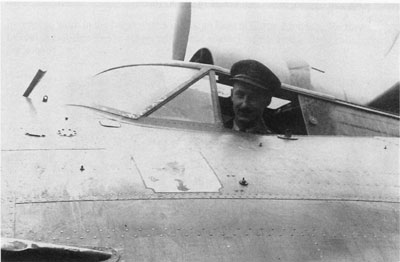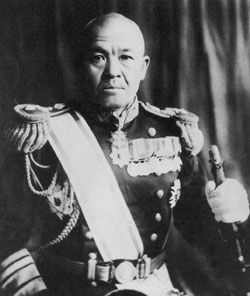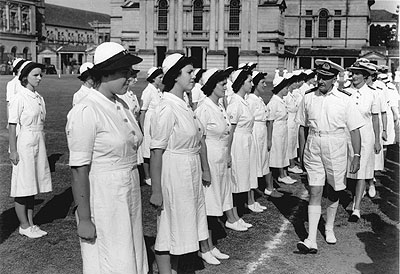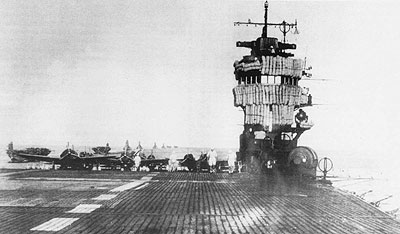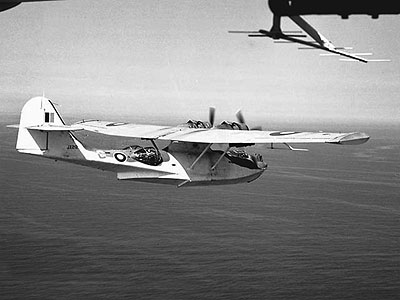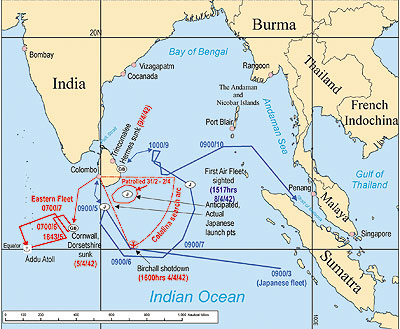Leonard Joseph Birchall
‘Saviour of Ceylon,’
National Defence and the Canadian Armed Forces
Leonard Birchall And The Japanese Raid On Colombo
by Rob Stuart
Introduction
Air Commodore Leonard Joseph Birchall, Member of the Order of Canada, Member of the Order of Ontario, Officer of the Most Excellent Order of the British Empire, Distinguished Flying Cross, Canadian Forces Decoration, Officer of the United States Legion of Merit, passed away in September 2004 at the age of 89. His passing was reported in most Canadian newspapers, and all of them noted that he had been nicknamed ‘the Saviour of Ceylon’ for having spotted a Japanese
fleet approaching Ceylon (now Sri Lanka)on 4 April 1942 while on patrol in a 413 (RCAF) Squadron Consolidated Catalina flying boat. Unfortunately, few accounts of Birchall’s actions that day paint a full picture of the combat operations in which his sighting report played an important factor. The aim of this article is to put Birchall’s discovery of the Japanese fleet into the full context of the operations conducted off and over Ceylon between 26 March and 9 April 1942.
The force Birchall spotted was the First Air Fleet, the carrier battle group that had previously attacked Pearl Harbor. It was commanded by Vice Admiral Chuichi Nagumo, and it consisted of the carriers Akagi, Hiryu, Soryu, Shokaku, and Zuikaku, the battleships Kongo, Haruna, Kirishima, and Hiei, the heavy cruisers Chikuma and Tone, a light cruiser, and eight destroyers. It was a well-trained and powerful force, with more than 300 modern combat aircraft embarked, including considerable numbers of the superb Mitsubishi A6M Zero fighter. The primary purpose of the Japanese mission, which they called Operation C, was to secure Japan’s western flank by neutralizing British naval and air forces in the Indian Ocean. Secondary objectives included disrupting shipping in the Bay of Bengal, and encouraging the Indian independence movement, which desired to take India out of the war. In other words, this was a raid, and not an invasion of Ceylon.1
The British were still reeling from a string of recent disasters. Hong Kong, Malaya, Singapore, Borneo, and much of Burma had fallen, and the Japanese Army was approaching India’s eastern border. To stem the Japanese advance, such reinforcements as were available had been dispatched to the Far East. Among them was 413 Squadron, which, at the end of February, had been ordered to move to Ceylon from Sullom Voe in the Shetland Islands. The squadron’s four Catalinas departed Europe in mid-March, and its ground crews soon followed by ship.2
A new British Eastern Fleet was assembled in Ceylonese waters, and Admiral Sir James Somerville assumed command on 26 March 1942. It consisted of the modern fleet carriers Indomitable and Formidable, the small carrier Hermes, the battleships Warspite, Resolution, Ramillies, Royal Sovereign, and Revenge, the heavy cruisers Dorsetshire and Cornwall, five light cruisers, and 14 destroyers. This was a substantial force, but it had only just been assembled and it had not yet been trained to operate as a fleet. The four R-class battleships were old, slow, and short-ranged, and several of the cruisers and destroyers were past their prime. Most importantly, the two fleet carriers embarked only 80 aircraft between them. There were no dive bombers, and the 45 torpedo bombers were lumbering, antediluvian Fairey Albacore biplanes. The 35 fighters, comprising 14 Grumman Martlets, as the American-made Wildcat was known in British service, 9 Hawker Sea Hurricanes, and 12 two-seater Fairey Fulmars, were all inferior to the Zero, especially the Fulmar.3 The author of The World’s Worst Aircraft was perhaps going a little too far when he included the Albacore and Fulmar in his 2005 book, but it makes the point that the Royal Navy was stuck with some rather mediocre aircraft at the time.4
On the plus side, the British had radar and the Japanese did not.
The Eastern Fleet was well equipped with air search, surface search and fire control radar sets.5 Most of the Albacores also had radar, the air-to-surface-vessel (ASV) Mark IIN, which could detect a medium-sized ship at up to 15 miles range.6Finally, the British had a secret anchorage, Addu Atoll, at the southern end of the Maldives, some 600 miles southwest of Ceylon. In fact, the Japanese did not learn of this hideaway until after the war.
Somerville knew he would be outmatched if the Japanese sent their main striking force against him, but believed he could deal with a smaller detachment and also that he would have an advantage at night. To avoid battle on unfavourable terms, the admiral needed early intelligence with respect to any Japanese force entering the Indian Ocean. The key intelligence organization supporting him was the Far Eastern Combined Bureau (FECB). This formation was a signals intelligence (sigint) unit, and it received a steady flow of Japanese radio traffic from intercept stations located throughout the Far East and Pacific, including one based at Esquimalt, British Columbia.7
The FECB, in conjunction with US Navy sigint centres, was beginning to read main Japanese fleet code successfully from their encryption devices, known to the Allies as JN-25. By March 1942, the latest variant introduced during the previous December and known as JN-25B, had been reconstructed to the point where substantial portions of many messages could be read with little delay. Before the end of the month, US cryptographers determined that Japanese carriers were about to enter the Indian Ocean, and accordingly, a warning was sent to Colombo. FECB also repeatedly read of an imminent operation by a carrier force in the area of “D,” and an air raid on “DG” planned for either the first or second of April. The meaning of these geographic designators, a sort of ‘code within a code,’ was not clear, but “D” was thought to be either India or Ceylon.8 Fortunately, the meaning of “DG” was not clear to all the Japanese either, for on 28 March, one of their operators advised a colleague, in a JN-25B message read by FECB, that it represented Colombo.9
Somerville was warned the same day and advised that the Japanese would have “two or more” carriers, plus cruisers, destroyers and perhaps Kongo-class fast battleships.10 There were, in fact, five carriers, as we have seen, and they were accompanied by all four Kongos.
Somerville thought the Japanese would probably attack Colombo and Trincomalee, Ceylon’s principal ports, simultaneously, and he estimated that their launch point would be about 5° 20’ N, 80° 53’ E – roughly 100 miles southeast of Ceylon, and 180 to 200 miles from both ports. Catalina searches were therefore organized to a distance of 420 miles from Colombo, between the bearings of 110° and 154°, the direction from which the Japanese were expected to approach.11 In fact, the Japanese planned to hit only Colombo during their initial strike, so their actual launch point proved to be well to the west of Somerville’s estimate.
Initially, only six Catalinas were available for operations.12 As the patrols lasted up to 32 hours, only half the available aircraft could be available for patrol each day.13 This meant that each of the three aircraft had to cover an arced sector of about 15 degrees. In comparison, two months later, the US Navy dispatched 22 Catalinas from Midway Island to search a 180 degree arc for the Japanese task force predicted by sigint to be approaching, a resultant search arc of just 8 degrees per aircraft.14 This limitation highlights the weakness of the reconnaissance force upon which Somerville depended.
Fortunately, the small RCAF contingent was starting to arrive, in the proverbial nick of time. The first 413 Squadron aircraft, flown by RAF Flight Lieutenant Rae Thomas, DFC, arrived on 28 March, and flew its first mission three days later. Birchall, then a squadron leader, arrived on 2 April with the second aircraft.15
Into Action
Somerville ordered the Eastern Fleet to sea on 30 March. His ships left Colombo, Trincomalee, and Addu Atoll, and rendezvoused 80 miles south of Ceylon at 1600 hours the following day. Seeing them assembled for the first time, he signaled, “So this is the Eastern Fleet. Never mind, many a good tune is played on an old fiddle.”16
The admiral also organized the fleet into two divisions. Force A, led by himself, included Warspite, Indomitable, Formidable, Cornwall, Dorsetshire, two light cruisers, and six destroyers. Force B, the slow division, consisted of the four R-class battleships, Hermes, three light cruisers, and eight destroyers.
As Admiral Somerville had been instructed by London that it was more important to preserve the Eastern Fleet than to defend Ceylon,17 one might have expected him to lead his ships well out of harm’s way. There were two reasons why he did not. The first was his native pugnacity. In his own words, he wanted to give the enemy “a good crack.”18 It was not for nothing that his eventual biography was to be entitled Fighting Admiral. The second reason was that the available intelligence led him to believe he could seek battle on favourable terms. He had been told when the enemy would arrive, and that there might be as few as two carriers opposing him. Furthermore, British naval intelligence had underestimated the capabilities of Japanese carriers. For instance, it was thought that the Shokaku and Zuikaku carried 60 aircraft apiece, but in reality, they could operate 72 aircraft each and carry another 12 for spares.19 The performance of their aircraft was likewise underestimated. Despite such occurrences as the participation of the Zero in the 8 December attack on targets near Manila, 450 miles from the Japanese bases on Formosa (Taiwan), its tremendous range was not yet fully appreciated. This was partly due to the fact that the various Allied commands did not broadly or promptly share their after action reports, which worked to their mutual disadvantage.20
Operation C gets underway, 26 March 1942: Akagi leaves Staring Bay, to be followed by Soryu, Hiryu, the battleships Hiei, Kongo, Kirishima and Haruna, then carriers Shokaku and Zuikaku. Note that Akagi and Hiryu have portside bridge structures.
Somerville thought the Japanese aircraft would probably attack in moonlight – there was a full moon on 1 April – and arrive back over their carriers at dawn, at approximately 0600 hours.
To accomplish this, Nagumo would have to reach his launch point by about 0200 hours. Somerville decided to ambush him. If his radar-equipped force found radar-deficient Nagumo during the night, he could launch a torpedo aircraft strike with a fair prospect of inflicting damage. Until last light on 31 March, he kept well to the west, out of range of Nagumo’s search aircraft, and then headed straight for the anticipated Japanese launch point, which he reached at 0230 hours. Not finding Nagumo during the night of 31 March/ 1 April, the admiral withdrew southwestward to remain out of range of his opponent’s daylight searches on 1 April,
in case the Japanese appeared on the scene unexpectedly. He then headed back toward Nagumo’s anticipated launch point during the night of 1/2 April, and withdrew again before daylight on 2 April. At last light on 2 April, the third night, he again started searching to the east.
By 2100 hours on 2 April, having seen no sign of the Japanese after three days, Somerville decided that their attack had likely been cancelled. He could not keep his fleet at sea much longer in any case, as his four R-class battleships could not produce enough fresh water for their boilers for more than a very few days. He therefore led the fleet to Addu Atoll to replenish, partly because most of his auxiliary vessels had already been sent there, and partly to stay clear of Colombo, in case the Japanese belatedly appeared there after all. However, he had to send Cornwall and Dorsetshire to Colombo, the former to escort a troop convoy, and the latter to resume a refit. He also sent Hermes and Vampire to Trincomalee, to resume preparations for the upcoming occupation of Vichy French-controlled Madagascar, code-named Operation Ironclad.21
Operation C had not been cancelled. It was, in fact, carried out as predicted by sigint, but not on the first or second of April. One source explains the delay by claiming that Nagumo decided to wait until 5 April, as that was Easter Sunday, and he hoped to catch the British in port for the holiday.22 Other sources note that between 11 and 16 March, Shokaku and Zuikaku made an unplanned sortie to search for a US carrier task force thought to be approaching Japan, and they did not rejoin the First Air Fleet at Staring Bay, off Kendari on the island now known as Sulawesi (then Celebes), until 24 March.23 Nagumo set sail on Operation C from there on 26 March but it is not clear if that was the originally planned date, or if it represented a postponement for either of the aforementioned reasons.
At 1600 hours on 4 April, Birchall and his crew sighted the First Air Fleet 360 miles from Dondra Head, the southernmost point in Ceylon, bearing 155 degrees from Ceylon.24 As noted earlier, they had just arrived in Ceylon on 2 April. They were given 24 hours to rest after their 10-day trip from Sullom Voe, but then, before being given any opportunity to familiarize themselves with their new operational area, they were ordered to join the search for Nagumo. They took off from Lake Koggala, the Catalina base on the south coast of Ceylon, before dawn on 4 April, and they were scheduled to return after dawn on 5 April.
Birchall arrived in his patrol area just as the sun rose. Hour after hour, the Catalina flew 150 mile-long east-west lines, spaced 50 miles apart, at an altitude of 2000 feet over the water. While they were flying the last assigned leg, Birchall’s navigator, Warrant Officer Onyette, the only other Canadian aboard, pointed out that if they flew an extra leg, he could confirm their actual position by using the moon, which was then rising. Since they were required to remain airborne until after dawn the next day in any case, Birchall agreed.25
Birchall’s crew had been assigned the southernmost search sector. And just as they were completing this extra leg and were at the southernmost point in their search, ships appeared on the southern horizon. If the Japanese had been any further to the south, or if the Catalina crew had not flown the extra leg, they almost certainly would have escaped detection until their aircraft arrived over Colombo the next morning. What follows is Leonard Birchall’s own account of what happened next:
“As we got close enough to identify the lead ships we knew at once what we were into but the closer we got the more ships appeared and so it was necessary to keep going until we could count and identify them all. By the time we did this there was very little chance left.”
The Catalina was then attacked by up to 12 Zeros.
“All we could do was to put the nose down and go full out, about 150 knots. We immediately coded a message and started transmission …We were halfway through our required third transmission when a shell destroyed our wireless equipment and seriously injured the operator; we were now under constant attack. Shells set fire to our internal tanks. We managed to get the fire out and then another started, and the aircraft began to break up. Due to our low altitude it was impossible to bail out, but I got the aircraft down on the water before the tail fell off.”26
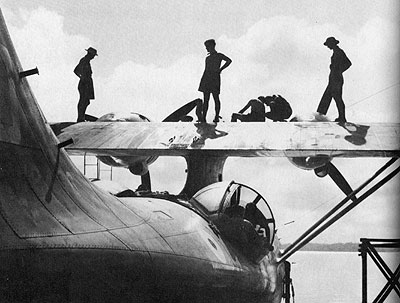
CMJ collection RCAF ground crew from No. 413 Squadron service a Consolidated Catalina flying boat in Ceylon during the spring of 1943.
The one-sided fight lasted just seven minutes. Stupidly, the Zeros strafed and sank the Catalina after it alighted, possibly forfeiting an opportunity for it to be boarded and searched for items of intelligence interest. The strafing also killed two wounded survivors floating in their life jackets, when they were about to be captured and could also have been interrogated. The destroyer Isokaze picked up the six surviving crew members.
The Japanese wished to know if the crew had transmitted a sighting report, but could think of no more sophisticated way of learning this then by administering repeated beatings. The airmen stuck to their story that they had not had time to use the radio before being shot down, but then the Japanese intercepted a message from Colombo asking the Catalina to repeat its report. This sigint success, apparently the only one the Japanese enjoyed during Operation C, led them to conclude that they had lost the element of surprise – and prompted them to beat the Catalina crew again.27
The element of surprise had indeed been lost. Birchall’s message galvanized the British commanders. Colombo’s garrison and the RAF units on the island were ordered to stand-to from 0300 hours the next morning, and the harbour was cleared of warships and merchant vessels. About 60 vessels had been sent out of harm’s way following the 28 March sigint warning, and another 25 were dispatched now, including Cornwall and Dorsetshire. Two destroyers, a submarine, a submarine depot ship, an armed merchant cruiser, and 21 merchant ships were unfit for sea, and they remained in the harbour.28
Somerville was now badly out of position, having just entered Addu Atoll. As he recorded it, “Damn and blast it looks as if I’ve been had…here I am miles away and unable to strike.”29 Ultimately, the admiral sailed with Force A just as soon as it finished replenishing, which was not until midnight, and steered straight for the Japanese. Force B followed about eight hours later.
Japanese carrier task forces used the floatplanes of their escorting battleships and cruisers for reconnaissance and anti-submarine patrols, partly in order not to reduce the number of carrier aircraft available for offensive operations. Accordingly, at first light on 5 April, several floatplanes were launched to search the surrounding seas. A short time later, the carriers dispatched 127 aircraft to attack Colombo. Commander Mitsuo Fuchida, who had led the strike on Pearl Harbor, led the strike force.
Colombo was defended by 42 fighter aircraft. Stationed at Ratmalana airfield were 30 Squadron, with 22 Hurricanes, and 803 and 806 Squadrons, with just six Fulmars between them. 258 Squadron, with 14 Hurricanes, was located at the local racetrack, using an improvised strip, of which the Japanese were ignorant. Several of the pilots were Canadians. Colombo was also defended by 18 heavy and 25 light anti-aircraft guns, and Ratmalana by four heavy and 12 light anti-aircraft guns.30
Despite Birchall’s warning almost 16 hours before, most of the defending fighters were still on the ground, with some pilots stood down for breakfast, when the Japanese arrived shortly before 0800 hours. The 30 Squadron on-line history claims that the local fighter controllers, under-estimating the range of the Zero, did not expect an attack that morning, but the First Air Fleet was only 360 miles off the island when sighted by Birchall. Even if the Zeros were as short-legged as the British supposed, Nagumo could easily have moved to a position from which they could reach Colombo early on 5 April. The on-line history also claims that the Colombo radar was unmanned and/or down for routine maintenance at the time. In fact, it had not even been set up yet. At about the same time that 413 Squadron had been ordered to move to Ceylon, the Royal Air Force rushed eight air surveillance radar sets to the island. One was operational at Trincomalee before the Japanese arrived, but the one deployed to Colombo was not.31
Instead of the tactical advantage of having the defending fighters awaiting the Japanese from above, it was now the Japanese who held the advantage of height. And the defenders suffered accordingly. Almost half the defending force – four Fulmars and 15 Hurricanes – was shot down, as were six Fairey Swordfish torpedo aircraft of 788 Squadron, which arrived on the scene from Trincomalee. In fact, the Swordfish, certain that any fighters over Colombo must be friendly, flashed recognition signals to identify themselves as British as the Zeros approached. The attackers also sank an old destroyer and an armed merchant cruiser, damaged a few other ships, and battered various shore installations. Only seven Japanese aircraft were lost, but another 15 were damaged. Ten Bristol Blenheim light bombers of 11 Squadron took off from Ratmalana at 0830 hours to attack the Japanese fleet, but failed to locate it.32
The defenders of Colombo were not the only ones to be affected by underestimation of Japanese capabilities.
In response to Birchall’s sighting report, Cornwall and Dorsetshire left Colombo at 2200 hours on 4 April, but instead of being sent to the west, to get well out of range of Nagumo’s aircraft,
they were sent to the southwest, toward Addu Atoll. Captain Agar, VC, of the Dorsetshire was the Senior Officer. During the night, he received orders from Somerville to join Force A, and, accordingly, altered course to almost due south at 0700, which kept him within range of Nagumo that much longer.33
A floatplane from Tone sighted the British cruisers at 1200 hours. Nagumo promptly dispatched 88 Aichi D3A Val dive bombers, which began their attack at 1338 hours. By 1355, in a remarkable display of bombing efficiency, Dorsetshire and Cornwall were both sunk.
Birchall’s sighting report had arrived in time to prevent the loss of these valuable ships, but poor intelligence on Japanese aircraft performance led to their being risked too close to Nagumo’s force. To quote Captain Agar,
“One point which had escaped the notice of everyone…was the range and performance of the Japanese naval aircraft…[W]e gave them the same performance as our own, but it later transpired that we had sadly underrated them. Actually, they had nearly double our performance. It is not surprising therefore that when next day [5 April] we sighted the first Japanese ‘shadower’ on the horizon astern, we had no idea at the time that they could possibly reach out so far, otherwise the R/V [the rendezvous with Somerville] would have been placed even further to the west.”34
A certain lack of enterprise on the part of the Japanese scouting aircraft must also be acknowledged. It apparently never occurred to their crews that the cruisers may have been heading for a rendezvous with other British ships. So far as is known, the floatplanes that found Agar’s ships concentrated on maintaining contact with them, instead of searching farther down their apparent track. Somerville was very fortunate that this was the case, as Force A was only 84 miles from the cruisers when the Vals began their attack. This distance is precisely known, since the Vals were detected on Warspite’s radar.35
In contrast, two months later, a group of US Navy dive bombers showed no such lack of enterprise when they came upon a Japanese destroyer proceeding independently on an unknown mission. Altering course to search along the destroyer’s track, they found and sank the carriers Akagi and Kaga, turning the Battle of Midway into a great American victory. What is in a name, you say? Appropriately enough, they were from USS Enterprise.36
(Larger image)
By sunset on 5 April, Somerville was in a surprisingly favourable position, despite the unnecessary loss of his heavy cruisers. He had closed to within 200 miles of Nagumo during the afternoon, but instead of being destroyed by his more powerful opponent, he remained undetected. There was now every prospect that he could launch a night torpedo attack with his Albacores. As Japanese carrier aircraft did not operate at night, their task force would be defended only by anti-aircraft guns, and would not be able to launch a retaliatory strike until first light, by which time Somerville could be out of range.
Unfortunately, Somerville did not receive accurate intelligence on Nagumo’s movements. Following Birchall’s sighting report on 4 April, which apparently did not indicate how many carriers Nagumo possessed, other Catalinas were dispatched to regain contact, and, starting at 0700 hours the following morning, Somerville launched air searches ahead of Force A. Numerous sightings were made, but the reports were incomplete, contradictory, often late, and, in some respects, just plain wrong. This is easily understood when one remembers that the search aircraft were highly vulnerable to the defending Zeros, which shot down an RAF Catalina in the morning and an Albacore from Indomitable in the afternoon.37
Consider this account from the second pilot of a RAF Catalina that found Nagumo on the morning of 5 April:
“We invented on the spur of the moment an obvious tactic for survival. We flew at wave-slapping height and then, with all the crew placed at vantage points for look out, pulled briefly up to 100 feet. If no Japanese masts broke the horizon we went down to nought feet again and flew on to where the distant horizon had been. Here we repeated the exercise. In this way we successfully shadowed the Japanese, never, after the initial identification, seeing more than the tops of their masts…”38
The upshot was that Somerville had great difficulty finding Nagumo. Finally, at 1817 hours, he was advised that five Japanese vessels sighted about 120 miles away, two of them carriers, were steering to the northwest. Somerville immediately altered course to northwest himself, to keep within striking distance. Receiving no further reports, he maintained this course through the night, with radar-equipped Albacores searching to the north and northeast, but they found nothing.
If the five Japanese vessels in fact were steering to the northwest at 1600 hours, it was only a brief alteration from their mean course. When Somerville altered course to the northwest, Nagumo was actually steering southeast, and he was soon beyond reach.39
Admiral Somerville continued to search for Nagumo to the southwest of Ceylon until he re-entered Addu Atoll on 8 April. After a conference there with his senior officers, among them the rescued captains of Cornwall and Dorsetshire, Somerville finally realized how seriously outmatched he was. It was now clear that his fighters would not be able to ward off large-scale attacks like the one that sank his heavy cruisers, that the R-class battleships were liabilities, and that Colombo, Trincomalee, and Addu Atoll were not secure bases. He therefore sent Force B to the east coast of Africa, where it could protect the sea route to the Middle East, and personally led Force A to Bombay.40 The Eastern Fleet did not move back to Ceylon until September 1943.
RCAF pilots serving with the RAF’s 30 Squadron in April 1942. All seven survived the 5 April attack on Colombo.
What Then Transpired
The rest of Operation C can be described quickly. Admiral Nagumo remained beyond Catalina range, swung around to the east of Ceylon, and attacked Trincomalee on 9 April 1942. Events there mirrored those at Colombo in several ways. Nagumo’s force was sighted at 1517 hours on 8 April by an RAF Catalina. All seaworthy vessels in Trincomalee harbour, including Hermes, were ordered to sail. No further contact with the Japanese was made until 0706 hours the next day, when the radar station at Trincomalee detected aircraft approaching at a range of 91 miles. The defending fighters were scrambled in good time, but there were only 23 of them – 17 Hurricanes and 6 Fulmars – against 132 Japanese aircraft. Together with the anti-aircraft guns they managed to shoot down only four of the attackers, and the defences lost eight Hurricanes and a Fulmar. Both the RAF station and the docks were heavily bombed, the monitor Erebus was damaged, and a merchant ship was set ablaze.41
Overall, the raid on Trincomalee produced disappointing results for the Japanese, but just after it ended, a floatplane from Haruna sighted Hermes and its sole escort, Vampire. The 80 Vals on standby readiness aboard the Japanese carriers were promptly dispatched, and they arrived over the two British ships at 1035 hours.
By 1055 hours, both of them were sunk, and the Vals that still had bombs attacked other ships nearby, sinking the corvette Hollyhock, the naval auxiliary Athelstone, the tanker British Sergeant, and the cargo ship Norviken. Four Vals were shot down by Fulmars, which arrived after Hermes sank. Two of the Fulmars were also lost.42
Just before Japanese bombers arrived over the British carrier, British bombers, in turn, arrived over a Japanese carrier. Nine unescorted 11 Squadron Blenheims attacked Akagi at 1025 hours. No Japanese lookout sighted the Blenheims until they dropped their bombs. This was the first time any ship of the First Air Fleet had been attacked since the war began. A few near misses were scored, but no hits, and four of the attacking Blenheims, a notoriously frail aircraft, were shot down. The remaining five got away, but then had the misfortune to meet Zeros returning from the strike on Hermes. Another Blenheim was shot down, but the Blenheim force managed to shoot down two of the Zeros.43
Another 413 Squadron aircraft was lost on 9 April. This was the Catalina of RAF Flight Lieutenant Thomas, which sighted the Japanese at about 0716 hours. Its sighting report faded before being completely received and it was presumed, correctly as it materialized, that it had been shot down. There were no survivors.44
Admiral Nagumo then headed for Japan as soon as he recovered the aircraft from the Hermes strike. During Operation C, he had destroyed an aircraft carrier, two heavy cruisers, two destroyers, one corvette, and five other vessels, and had shot down 45 aircraft. A separate squadron, with the light carrier Ryujo and several cruisers, sank 21 merchant ships during a concurrent foray into the Bay of Bengal, and the six submarines deployed for the operation sank five more.45 The Japanese lost just 17 aircraft, and no Japanese ship was even damaged.
Conclusions
Having surveyed Operation C, let us now reconsider the impact of Birchall’s discovery of Admiral Nagumo’s force on 4 April 1942. 413 Squadron’s on-line history46 says Birchall “is credited with saving the island,” and a Sri Lankan writer claims that [5 April 1942] was “the day Ceylon escaped Japanese occupation.”47 Leslie Robert’s history of the RCAF, There Shall be Wings, claims: “A single Canadian Catalina and its crew… averted a second Pearl Harbor.”48
It is simply not true that Birchall saved Ceylon from occupation, for the straightforward reason that the Japanese had no intention of invading it at that time. As we have seen, Operation C was just a raid.
The claim that Birchall prevented a second Pearl Harbor is closer to the truth, even though the bulk of the Eastern Fleet, the main Japanese target, was at Addu Atoll, and not Colombo. His sighting report permitted Cornwall and Dorsetshire to sortie before the attack, but miscalculation and under-estimation of Japanese aircraft performance led to their loss all the same.
The same problems, and the lack of radar, led to most of the fighters defending Colombo being caught on the ground. His warning did allow 25 merchant ships to flee Colombo harbour and to get clean away. It also permitted Somerville to leave Addu Atoll eight hours before Colombo was attacked, giving him a chance to launch an air attack on Nagumo during the night of 5-6 April. But just as night fell, a false report sent him haring off in the wrong direction.
It is often asserted that it was Churchill who dubbed Birchall the ‘Saviour of Ceylon,’ but this appears not to be the case. The Official History of the RCAF, Volume 3, an authoritative source, acknowledges that this label was bestowed by the Canadian press.49 However, Churchill did say that Birchall “made one of the most important single contributions to victory,” but this was in 1946,50 when the British still thought they had destroyed more than 50 of Nagumo’s aircraft, and that Japan had contemplated invasion. He did not repeat this compliment when he discussed Operation C in his war memoirs, penned circa 1950. Indeed, Birchall was not even named, and his aircraft was described simply as “a Catalina.”51
This article is not an attempt to put forward a revisionist view of Birchall’s actions on 4 April 1942. He did everything he is said to have done, and he certainly deserves all the recognition he has received. However, it is argued here only that his sighting report did not result in Ceylon being saved. Strictly speaking, it is therefore not historically accurate to call him the ‘Saviour of Ceylon,’ – but, in my view, we should do so all the same. Monikers defy logic. Perhaps he should have a nickname that recalls his three-and-a-half years of sustained courage and leadership as the senior Allied officer in several brutal Japanese prison camps, for which he was awarded a rare Gallantry category of the Order of the British Empire, rather than for his single day of Pacific theatre combat, for which he received the Distinguished Flying Cross. Asking his many admirers, among whom the current author counts himself, to instead refer to him as ‘Hero of Ceylon,’ or some other more narrowly accurate but bland nickname, would be as unappealing as it would be futile. Leonard Birchall should be remembered for his heroism, and there is no doubt that he will always be the ‘Saviour of Ceylon’ in the eyes of most people who knew him or of him.
Rob Stuart BA, B Ed, CD, served in the regular and reserve components of the Canadian Forces from 1975 to 1991 in the Communications and Electronics Branch and attained the rank of captain. He has been employed by the Communications Security Establishment since 1989.
Notes
1. David A. Thomas, Japan’s War at Sea: Pearl Harbor to the Coral Sea (London: Andre Deutsch, 1978), pp. 101-102. The Japanese Navy did hope to occupy Ceylon eventually, but its defeat in June at Midway ended all such ambitions. See Toshikazu Ohmae, “Japanese Operations in the Indian Ocean”, in The Japanese Navy in World War II, second edition, Dr. David C. Evans (ed.) (Annapolis, Maryland: United States Naval Institute, 1986), and C.B. 3303 (2) Naval Staff History – War with Japan, Volume II (London: Admiralty Historical Section, 1954), pp. 120-121. The last of these sources was based, in part, upon an enquiry held in Tokyo in 1948 expressly to determine if the Japanese planned to invade Ceylon.
2. Brereton Greenhous, Stephen J. Harris, William C. Johnston and William G.P. Rawling, The Crucible of War, 1939-1945. The Official History of the Royal Canadian Air Force Volume III (Toronto: University of Toronto Press, 1994), pp. 384-385, and T. W. Melnyk, Canadian Flying Operations in South East Asia 1941-1945 (Ottawa: Department of National Defence, 1976), pp. 26-27.
3. Thomas, p.93; J.D. Brown, Carrier Operations in World War II, Volume One, The Royal Navy (London: Ian Allan, 1968), p. 120; Christopher Shores and Brian Cull, with Yasuho Izawa, Bloody Shambles, Volume Two, The Defence of Sumatra to the Fall of Burma (London: Grub Street, 1993), pp. 384-386. There are discrepancies concerning the number of Martlets carried by Formidable. The number 14 is derived by accepting the figure of 16 given in Shores et al and subtracting the 2 Martlets flown ashore for training prior to the Japanese raid, cited therein.
4. Jim Winchester, The World’s Worst Aircraft, From Pioneering Failures to Multimillion Dollar Disasters (London: Amber Books, 2005), pp. 28-29, and pp. 32-33.
5. J.F. Coales and J.D.S. Rawlinson, “The Development of UK Naval Radar”, in Radar Development to 1945, Russell Burns (ed.) (London: Peter Peregrinus Ltd, 1988); Derek Howse, Radar at Sea, The Royal Navy in World War 2 (Annapolis: Naval Institute Press, 1993) pp. 63, 112, and 160.
6. Shores et al, p. 386; Howse, p. 308. Melnyk p. 38 gives the range of the ASV IIN as 12 to 24 miles.
7. Peter Elphick, Far Eastern File: The Intelligence War in the Far East, 1930-1945 (London: Hodder and Stoughton, 1997), pp. 339-347; Jozef Straczek, “The empire is listening: naval signals intelligence in the Far East to 1942”, in the Journal of the Australian War Memorial, at <http:// www.awm.gov.au/journal/j35/straczek.htm>.
8. John Prados, Combined Fleet Decoded: The Secret History of American Intelligence and the Japanese Navy in World War II (New York: Random House, 1995), p. 274.
9. Michael Smith, The Emperor’s Codes: The Breaking of Japan’s Secret Ciphers (New York: Arcade, 2000), pp. 128-129.
10. Battle Summary No. 15, “Naval Operations off Ceylon 29th March to 10th April, 1942” (Admiralty Training and Staff Duties Division, 1943), p. 2.
11. Ibid.
12. Multiple sources say there were six Catalinas, or six plus a spare, “at the end of March” but there is a certain amount of uncertainty surrounding this figure since two sources identify only five RAF Catalinas. There were also four Dutch Catalinas on the island, but their serviceability is in doubt. See Shores et al, pp. 390-391, and Michael Tomlinson, The Most Dangerous Moment (London: William Kimber, 1976), pp. 68-69, and p. 79. The total of six probably includes one of the Dutch machines, but it is possible that the first 413 Squadron aircraft to arrive has been counted as the sixth Catalina, as it arrived before the end of March.
13. Melnyk, p. 16.
14. H.P. Willmott, The Barrier and the Javelin (Annapolis, Maryland: US Naval Institute Press, 1983), pp. 311-312, and p. 359.
15. Melnyk, p. 27; Greenhous et al, pp. 386-387; Dennis Baker, A History of 413 Squadron (Burnstown, Ontario: General Store Publishing, 1997) pp. 15-16.
16. Donald MacIntyre, Fighting Admiral, The Life of Admiral of the Fleet Sir James Somerville, GCB, GBE, DSO (London: Evans Brothers, 1961), p. 186.
17. Ibid, p. 178.
18. Michael Simpson (ed.), The Somerville Papers (Oxford, United Kingdom: Scolar Press, 1995), p. 398.
19. Arthur J. Marder, Old Friends, New Enemies: The Royal Navy and the Imperial Japanese Navy: Strategic Illusions, 1936-1941 (Oxford, United Kingdom: Oxford University Press, 1981), p. 300.
20. Willmott, p. 301, cites the case of the US Chief of Naval Operations, Admiral King, withholding information on the Battle of the Coral Sea from his Royal Navy and US Army counterparts.
21. Battle Summary 15, pp. 2-4; C.B. 3303 (2), pp. 124-125.
22. Thomas, p. 104.
23. John Parkinson, “Vice-Admiral Nagumo in the Indian Ocean: April 1942”, summarized in Newsletter No. 357, Kwazulu-Natal Branch, South African Military History Society, June 2005, at <http://samilitaryhistory.org/5/d05junne.html>; Tabular Records of Movement for Shokaku, Ise, Hyuga and Kiso, at .
24. Battle Summary 15, p. 4.
25. Baker, pp. 15-17.
26. Ibid; Shores et al, p. 394.
27. Shores et al, p. 395; Baker, p. 17.
28. Battle Summary 15, p. 5.
29. Simpson, p. 399.
30. Battle Summary 15, p. 6.
31. Wing Commander John Barras, “The Battle of Ceylon – 1942”, at <http://www.raf.mod.uk/history/ceylon2.html>; Battle Summary 15, p. 6; Henry Probert, The Forgotten Air Force: The Royal Air Force in the War Against Japan 1941-1945 (London: Brassey’s, 1995), pp. 98-99.
32. Thomas, p. 109; Shores et al, pp. 403-5; Paul S. Dull, A Battle History of the Imperial Japanese Navy (1941-1945) (Annapolis, Maryland: United States Naval Institute, 1978), p. 108.
33. Battle Summary 15, p. 7.
34. W.S. Agar, Footprints in the Sea (London: NP, 1959), p. 304, quoted in Arthur J. Marder, Mark Jacobsen and John Horsfield, Old Friends, New Enemies: The Royal Navy and the Imperial Japanese Navy, vol. 2: The Pacific War, 1942-1945 (Oxford, United Kingdom: Oxford University Press, 1990).
35. Battle Summary 15, p. 11.
36. Willmott, pp. 419-420.
37. Battle Summary 15, p. 6, p.11, Plan 4; Shores et al, p. 405.
38. Tomlinson, p. 115.
39. Battle Summary 15, pp. 11-12.
40. Ibid.
41. Ibid, pp. 13-14; Shores et al, pp. 412-421.
42. Shores et al, pp. 422-429.
43. Ibid, pp. 425-426.
44. Battle Summary 15, p. 13; Melnyk, p. 30; Baker, p. 18.
45. Battle Summary 15, p. 24.
46. <http://www.airforce.forces.gc.ca/14wing/squadron/413hist_e.asp>
47. Gamini de Silva, “April 5, 1942 the day Ceylon escaped Japanese occupation”, at <http://www.lankalibrary.com/geo/japan2.htm>
48. Leslie Roberts, There Shall Be Wings (Toronto: Clarke Irwin, 1960), pp. 150-151.
49. Greenhous et al, p. 386.
50. Tomlinson, pp. 20-21.
51. Winston S. Churchill, The Hinge of Fate (Boston: Houghton Mifflin, 1950), pp. 178-179.
